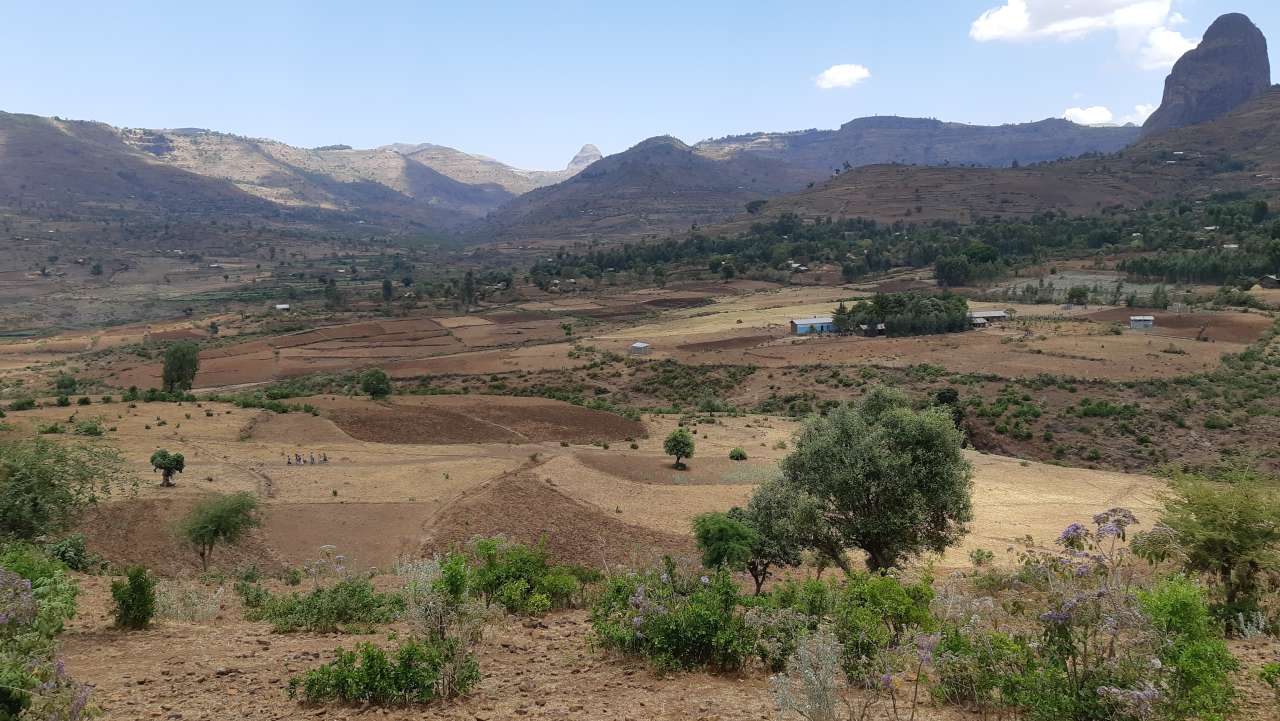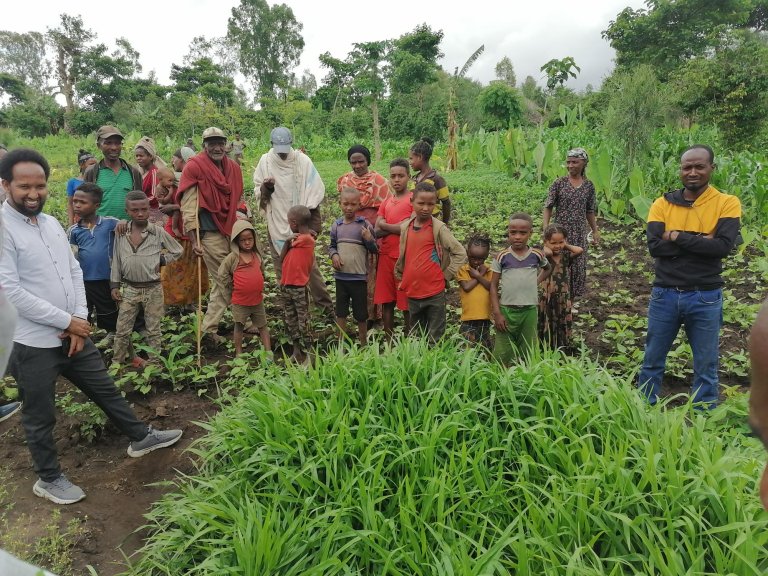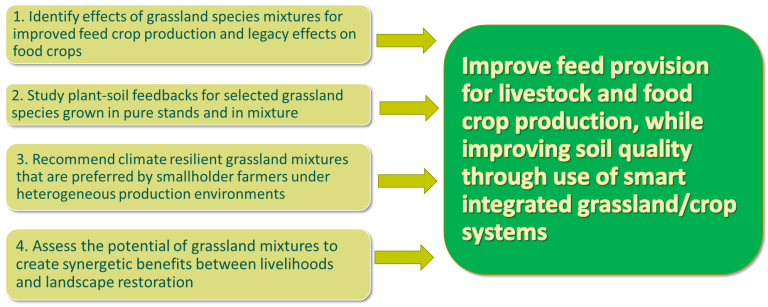Division of Food Production and Society
EthiopiaGrass

End: dec 2024
Start: mar 2021
Perennial grassland mixtures: a novel approach to forage and food production, land restoration and climate resilience in Ethiopia (EthiopiaGrass).
Project participants
Kalkidan Ayele Mulatu An M. O. Notenbaert Shimelis Gizachew Raji Bimrew Asmare Niklas Wickander Solomon Mwendia Peter Dörsch Wuletawu Abera Caroline Brophy Karl ThunesEvaluating potential environmental co-benefits of perennial grass-legume mixtures in Ethiopia
Keynote Tropentag 2024, 12 September 2024, Vienna
Unlocking farmer-preferred multipurpose forage mixtures: a tricot approach in Ethiopia
Keynote Tropentag 2024, 12 September 2024, Vienna
Grass-legume mixtures: a novel approach to forage production in Ethiopia
Proceedings of the 22nd EGF Symposium. Vilnius, Lithuania 11-14 June 2023. Grassland Science in Europe 28, 149-151, eISBN: 978-609-451-008-3.
Farmes Field Day at Bilate Zuria District
Site visits and meetings
Report on the second Multi-Actor Platform meeting and site visit of EthiopiaGrass project
EthiopiaGrass
Project brief from CIAT.
| Status | Active |
| Start - end date | 01.03.2021 - 31.12.2024 |
| Project manager | Marit Jørgensen |
| Division | Division of Food Production and Society |
| Department | Grassland and Livestock |
| Partners | Norwegian University of Life Sciences (NMBU), Hawassa University Ethiopia, Bahir Dar University Ethiopia, Centre for Tropical Agriculture (Alliance Bioversity & CIAT), Ethiopia and Kenya, Trinity College Dublin Ireland |
| Funding source | The Research Council of Norway (RCN), NMBU |
Novel farming systems are needed to counteract land degradation, which is a major threat to ecosystems and livelihoods in Sub-Saharan Africa, and in Ethiopia in particular.
Livestock provides significant rural employment and is central to the Ethiopian economy, but also contributes to land degradation. Land is scarce and about 90% of livestock feed is currently derived from shared grazing on highly overgrazed community pastures, exacerbating soil and land degradation. Climate change is predicted to worsen the situation, threatening ecosystems and livelihoods. Developing agriculture in Ethiopia towards robust and sustainable farming systems requires drastic changes in livestock and land management.
Novel integrated grassland/crop systems
The project EthiopiaGrass focuses on novel integrated grassland/crop systems to improve feed provision for livestock and production of food crops, while improving soil quality. Well-managed grasslands, used for forage production with improved forage species can counteract soil degradation in several ways: by improving feed provision, which alleviates the grazing pressure on land used for food crops; by directly improving soil quality through reduced soil erosion and increased amounts of organic matter returned to the soil; by building soil quality and fertility over time, thus supporting increased food crop yields once they are ploughed (legacy effect).

EthiopiaGrass will identify effects of diverse pasture mixtures on forage and food crops, study plant-soil feedbacks for selected grassland species and mixtures and identify effects on soil quality, carbon storage and nutrient cycling. Field experiments with advanced statistical design have been established in two highland sites, Bahir Dar of the Amhara region, and Hawassa of the Sidama region, Ethiopia. Two grasses (Panicum maximum and Brachiaria hybrid) and two legumes (Stylosanthes guianensis and Desmodium intortum) have been sown in monocultures and various mixtures. A monocrop of maize is also included in the experiments. Yield, botanical composition and nutritive quality of the monocultures and mixtures will be evaluated, as well as yield of the maize crops. After growing the pastures for two years, all plots will be ploughed, and a maize crop will be planted to measure the legacy effect of the different pasture technologies. Screening experiments with six different grass species and four different legumes have also been established to evaluate their performance under the different climatic conditions. Plant-soil interactions will be measured in the field experiments, but plant-soil processes will be studied in more detail in climate chamber experiments. Large-scale farmer-led testing using citizen science will be used to understand farmers’ choices and preferences.
Project objectives

WP1: Grassland species and plant traits, effects of biodiversity on production, resilience and legacy
WP Leader: M. Jørgensen (NIBIO). Participants: N. Wickander - PhD student (NMBU), B. Asmare (Bahir Dar University, BDU), S. G. Raji (Hawassa University, HU), A. Notenbaert (Alliance/CIAT), C. Brophy (Trinity College Dublin, TCD)
In the WP1 field experiments, grassland plots with monocultures and a range of mixtures of varying proportions are established from a pool of four forage species of mixed functional traits. After the grassland phase, a follow-on crop will be sown to gauge ‘legacy effects’ on yield and quality of a food crop. Parallel experimental work will be conducted on real farms in the vicinity of campus trials to ensure the grounding of the controlled experiments in a real-life setting and provide a formal basis for translating the experimental outcomes into transformative practice.
WP2 – Plant-soil interactions
WP Leader: P. Dörsch (NMBU). Participants: N. Wickander - PhD student (NMBU), S. Raji (HU), B. Asmare (BDU) M. Jørgensen (NIBIO), A. Notenbaert (Alliance/CIAT).
To facilitate sustainable intensification of forage production in Ethiopia, grassland mixtures must be optimized beyond yield, and plant feedbacks on soil quality, carbon storage and nutrient cycling must be identified. WP2 will study appropriate endpoints both in field experiments (WP1) in Ethiopia and in greenhouse experiments in Norway.
WP3 – Large-scale farmer-led grassland testing, and synergies and trade-offs at household and landscape levels
WP leader: A. Notenbaert (Alliance/CIAT) Participants: Postdoc (NIBIO), W. Abera (Alliance/CIAT), K. de Sousa (Alliance/Bioversity).
WP3 takes an interdisciplinary, mixed methods and participatory approach to test whether the technologies emerging as productive, climate-resilient and beneficial for soil quality from controlled on-station and on-farm experiments in WP1 and WP2 fit into farming systems and are preferred by smallholders. The analysis of trade-offs and synergies across household and landscape level is crucial for understanding technology adoption as well as aligning the research with national livestock and land restoration objectives.
WP4: Synthesis and development outreach
WP leader: W. Abera (Alliance/CIAT). Participants: Postdoc (NIBIO), K. Thunes (NIBIO), A. Notenbaert (Alliance/CIAT), all project participants.
Dissemination of research results from this project to relevant stakeholders strongly relies on the synergetic embedment with existing development-oriented projects in Amhara and Sidama regions. This embedment constitutes a win-win situation, where development projects benefit from state-of-the-art research and technical input, while this research project can rely on long-term partnerships and social capital to disseminate findings. This WP will first establish regular interaction with multi-actor platforms (MAP) that are based on the existing long-term partner networks, then synthesize and package research results during writeshops into communication products targeting different groups of stakeholders, and finally disseminate content through the MAP within Ethiopia as well as communicate implications to the Norwegian public.
